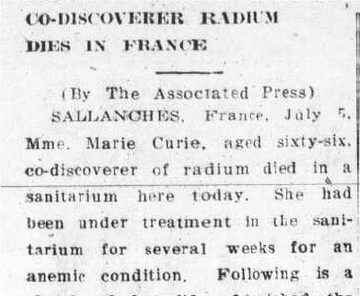Conclusion

The Gnome Nugget, Alaska, 1934
“It’s taken a century, but we can finally appreciate her as a multifaceted woman of uncommon intensity, intelligence and will—a woman of courage, conviction and yes, contradictions. After a century we see her not as a caricature, but as one of the 20th century’s most important scientists, who was, at the same time, unmistakably, reassuringly human.” Smithsonian Magazine (2011)
"I came to admire her human grandeur to an ever-growing degree. Her strength, her purity of will, her austerity toward herself, her objectivity, her incorruptible judgement - all these were of a kind seldom found joined in a single individual. If but a small part of Mme. Curie's strength of character and devotion were alive in Europe's intellectuals, Europe would face a brighter future." (Albert Einstein, 1935)
"The first experiments on the biological properties of radium were successfully made in France with samples from our laboratory, while my husband was living. The results were, at once, encouraging, so that the new branch of medical science, called radiumtherapy (in France, Curietherapy), developed rapidly, first in France and later in other countries. To supply the radium wanted for this purpose, a radium-producing industry was established. The first plant was created in France and worked very successfully, but afterwards manufactures were founded in other countries, the most important of which are now in America, where great quantities of radium ore, named “carnotite,” are available. The radiumtherapy and the radium production developed conjointly, and the results were more and more important for the treatment of several diseases, and particularly of cancer. As a consequence of this, several institutes have been founded, in the large cities, for the application of the new therapy. Some of these institutes own several grams of radium, the commercial price of the gram being now about $70,000, the cost of production depending on the very small proportion of radium in the ore."
"The use of the X-rays during the war saved the lives of many wounded men; it also saved many from long suffering and lasting infirmity."
"It may be easily understood how deeply I appreciated the privilege of realizing that our discovery had become a benefit to mankind, not only through its great scientific importance, but also by its power of efficient action against human suffering and terrible disease. This was indeed a splendid reward for our years of hard toil."
Marie Curie, from Kellog & Kellog, 1923, Autobiographical Notes
The story of Marie Curie demonstrates the importance of communication in understanding history. Both primary and secondary sources are crucial to the whole story. They must be examined in combination and with a critical eye that roots out bias. Curie wanted to be acknowledged as equal to men, yet many secondary sources painted her as a doting mother and philanthropist. Marie Curie was a scientist who rivaled her male counterparts. Her life and work impacted history greatly. She found a new method for discovering elements using radioactivity. Radium was a key to understanding matter and energy. Her work influenced the development of fundamental science, medical research and treatment, and especially cancer. Marie Curie shattered the female stereotype and popularized science in America. She died of radiation poisoning as a result of her dedication to science.